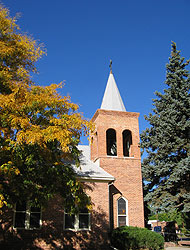Grant News
Church Preservation Project Rings True
“We have only heard the bell ring once,” proclaimed Harlan and Rose Linder in a letter to the State Historical Fund supporting an application for a grant to restore the United Methodist Church of Hygiene’s bell tower. “We feel that the community is missing an important part of its history. In these times of great anxiety, perhaps the soothing sounds of a bell ringing on a Sunday morning will bring a small amount of relief.”
The bell rang for the first time about one hundred years ago as Hygiene’s Methodist congregation celebrated the completion of what current members call “our beautiful little church.” The red brick structure added architectural substance to an expanding farming community of sixty souls.
Barely twenty-three years old then, the town was maturing almost as quickly as the fast-growing cottonwoods that line its streets and avenues. According to historians Tom Noel and Dan Corson, Hygiene got its start as Hygiene House, a tuberculosis sanitarium founded in 1882 by the Baptist Church of the Brethren. Reverend Jacob Flory, their minister, boosted Hygiene as a pristine health resort and farming colony in his newspaper, the Home Mirror. Though the spa went out of business, his aptly named town endured. According to the 1905 Colorado State Business Directory, its downtown consisted of two general merchandise stores, a feed mill, a drug store, one hotel, and a blacksmith shop.
Not much has changed since then. Hygiene has about the same number of businesses and a few more houses. An open space buffer and well-kept farms keep Longmont’s western subdivisions at bay. Tall cottonwoods—including America’s largest at 105 feet high—still shade inhabitants and the grateful cyclists who stop here for soda and espressos at the Coffee Stop.
But some things have changed. For members of the United Methodist Church, the cost of building maintenance and construction tops the list. As the aging building deteriorated, church coffers simply could not keep pace with increasingly expensive repairs. And the deferred upkeep didn’t just affect worshipers, it worried the entire community. The list of groups who use the church’s fellowship hall for events includes Girl Scout Troop 389, the St. Vrain Auto Club, the Longmont chapter of the Barbershop Harmony Singers, the Hoofs n’ Horns 4-H Club, the Swede Ditch Company, and others. The potluck dinners, chili suppers, choir practices, and meetings—not to mention all of the religious services—that have been held in this building define everyday life in Hygiene. So, when the church suffers, the town suffers.
Understanding the church’s importance to the community, members applied for a State Historical Fund grant to address the worst structural problems. The $92,756 they received augmented $23,918 in church funds and a $7,000 grant from the Boulder County Preservation Advisory Board. Atkinson-Noland and Associates drew up architectural and engineering plans for Sun Construction, the general contractor. Craftspeople repaired the bell tower, steeple, and roof; re-pointed water-damaged masonry walls; and reconstructed a broken chimney. Each of these problems had been previously diagnosed by a Historic Structure Assessment, also supported by an SHF grant.
Church lay leader and project administrator Andy Ernst is grateful for the Fund’s help. “We only have fifty-two members,” he says. “We couldn’t have done it on our own.”
Today, the United Methodist Church of Hygiene and its bell tower are safe and—pardon the pun—sound. “We ring the bell every Sunday,” says Ernst. “I think the community is happy to hear it again.”

